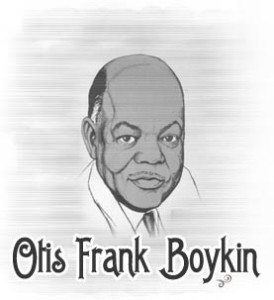Black History Month: Otis F. Boykin – Credited For Inventing An Improved Electrical Resistor & More


Born in Dalla, Texas on August 29, 1920, he joined Fisk College in Nashville, Tennessee after completing high school. Where he graduated in the year 1941 and worked as a lab assistant for the Majestic Radio and TV Corporation located in Chicago, Illinois. While working for this organization, he undertook numerous tasks, but showed exemplary competence when it came to testing automatic controls for aircrafts, this lead to him being appointed as the supervisor. After working there for three years, he left and obtained a job with P.J. Nilsen Research Laboratories where he worked as a research engineer. After some time at his new job, he decided to venture out on his own and try establishing his own business, hence he founded the Boykin-Fruth Inc.
It was at the same time he created his company, the Boykin-Fruth Inc. that he decided to pursue further studies. He joined Illinois Institute of Technology in Chicago, Illinois. He went for classes in the year 1946 and 1947 but had to discontinue his studies due to financial constraints. Although he really desired to obtain the masters degree, he came to terms that having a masters degree is not the prerequisite to achieving in his life. He therefore invested much of his time and brain to a project he had been thinking about while he was still in school. At this time, electronics field was quite popular within the science community, which made Boykin all the more interested in it, with a particular interest in resistors.
To those who don’t understand what a resistor is; it is an electronic component used to slow down the flow of electrical current in a circuit. It serves to protect excessive current flowing to components that require much less electrical current. Boykin made remarkable strides in this field which lead to him having a U.S. Patent on 16th June 1959 for a wire precision resistor. Boykin’s resistor allowed a controlled level of current to flow through electronics meant for a specific purpose. Before long, Boykin’s invention went viral and would be the standard resistor to be used in TVs and radios produced, up to the current time. After two years since his first patent invention, Boykin invented a second resistor that was quite cheap to manufacture. This in itself was strong plus in the industry of resistor manufacture, his second resistor had another advantage, it was able to withstand a wide degree of temperature change, stood up to a extreme pressure changes and physical trauma all the while its integrity remaining in check. Boykin’s resistor was now cheaper to manufacture and was more “hardy” so to speak, this lead to a high demand for Boykin’s resistor from numerous companies such as IBM, United States Military and consumer electronics manufacturers.
Boykin’s resistors allowed him to relocate to Paris in 1964 in order to create more of his innovations to the European market. His resistors were used in computers and other high profiled technologies such as the guided missile systems. Apart from the resistor, Boykin is also credited for inventing a chemical air filter and a cash register that is burglarproof. One very crucial invention Boykin made was the pacemaker control unit: which uses electrical impulses for the purpose of stimulating a patient’s heart thus creating a steady heartbeat. Ironically it was a heart failure that lead to Boykin’s demise in 1982. Nonetheless, Otis F. Boykin was a living and walking testament that dropping out of school, should not be the end of achieving your glory, he did not let this setback hold him back from becoming a great inventor whose invention would have effect on the world for hundreds of years to come.



